TEN YEARS AGO TODAY: MXA’S 2015 YAMAHA YZ450F TEST
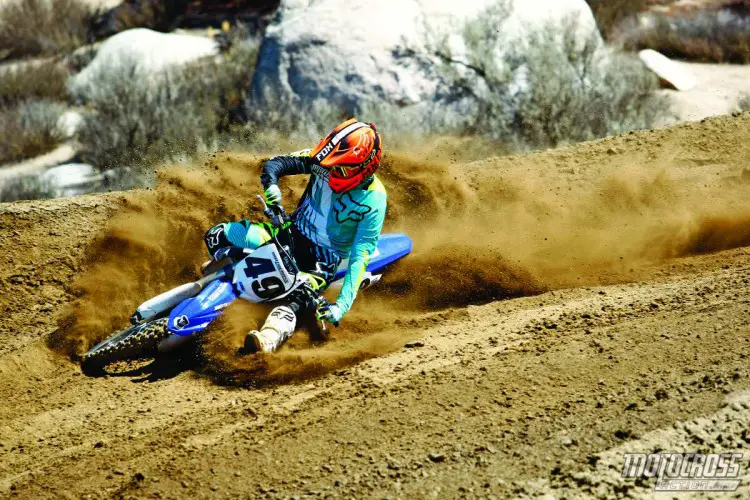
Q: FIRST AND FOREMOST, IS THE 2015 YZ450F BETTER THAN THE 2014 YZ450F?
A: Yes, but the MXA wrecking crew is at a loss as to why it is so much better. Nothing on the spec sheet would lead one to believe that this is a qualitatively improved machine. But, it is.
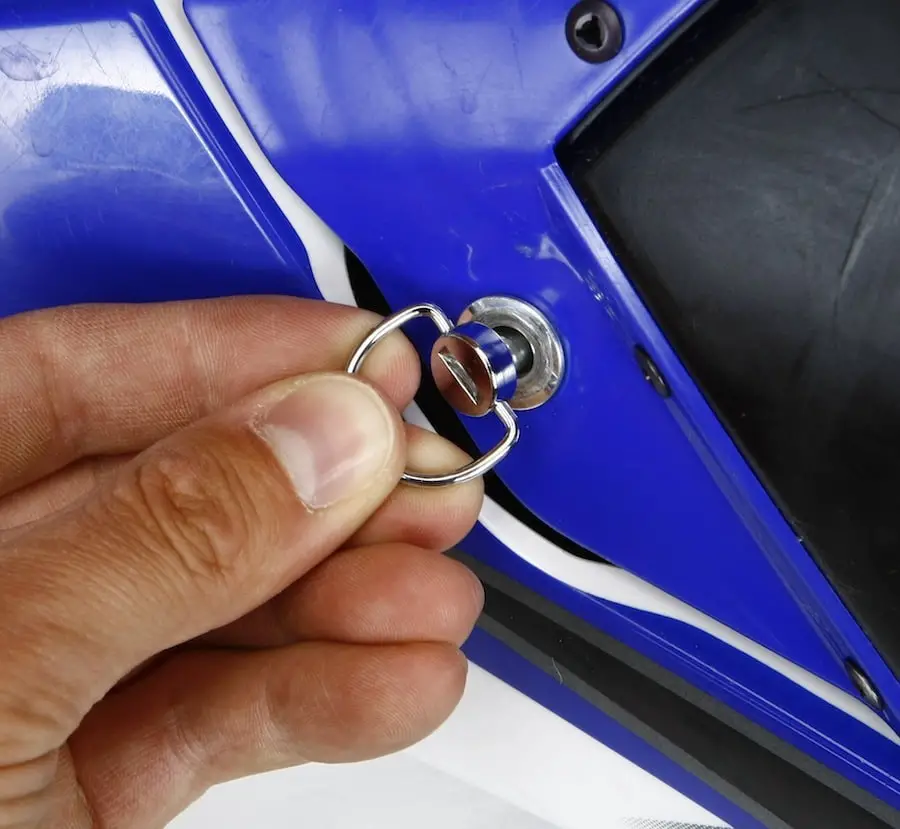 Word to the wise, remove the D-ring from the two Dzus fasteners on the sides of the airbox cover, you can leave the D-ring on the Dzus fastener on the front. If you don’t, they will fall off or hook on your pants. Once you remove the D-ring, you can use a screwdriver to remove them.
Word to the wise, remove the D-ring from the two Dzus fasteners on the sides of the airbox cover, you can leave the D-ring on the Dzus fastener on the front. If you don’t, they will fall off or hook on your pants. Once you remove the D-ring, you can use a screwdriver to remove them.
Q: WHAT ARE THE MAJOR CHANGES THAT YAMAHA MADE TO THE 2015 YZ450F?
A: It is important to remember that the 2014 Yamaha YZ450F was totally new from the ground up; only the rear wheel, front fender and brakes were left over from 2013. We give you this info as a lead-in to the fact that we never expected Yamaha to make any changes to the 2015 YZ450F. No motorcycle manufacturer has the R&D budget to build a totally new bike one year and then significantly change it the next year. As a rule of thumb, bikes have to live through a four-year development cycle, which means that the 2014 Yamaha YZ450F should remain basically the same until 2018.
Here is the short and tidy list of what’s new for 2015.
(1) Forks. The Kayaba SSS forks have new valving, stiffer fork springs and a redesigned fork-tube wall thickness for more resilience.
(2) Rims. The Excel rims are black anodized and equipped with Dunlop Geomax MX52 tires.
(3) Airbox. Instead of bolts, Yamaha holds the airbox cover in place with three, quick-release, quarter-turn Dzus fasteners.
(4) Mapping. The Electronic Control Unit (ECU) has been remapped for 2015.
(5) Throttle return spring. The spring on the EFI throttle body has been lightened 20 percent for easier roll-on.
(6) Motor mounts. The previous aluminum lower- motor mounts have been replaced with reshaped steel plates to allow a little more flex in the front of the frame.
(7) Gearing. The rear sprocket went from 49 teeth to 48 teeth.
(8) Gear-stop lever. To aid in shifting, the gear-stop lever has been changed to a roller type.
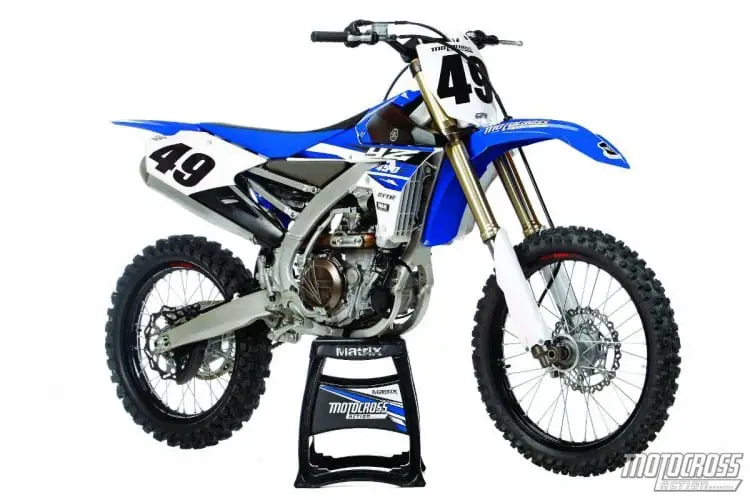 Mirror image: It doesn’t look a lot different than last year’s YZ450F, but something has changed under the hood.
Mirror image: It doesn’t look a lot different than last year’s YZ450F, but something has changed under the hood.
Q: WHAT DO THESE EIGHT RATHER BASIC CHANGES FOR 2015 ADD UP TO?
A: Right off the bat, we can discount the black rims, Dzus fasteners, throttle return spring and gear stopper as major contributors to the 2015 Yamaha YZ450F’s improved feel. With four changes eliminated, let’s analyze the remaining four.
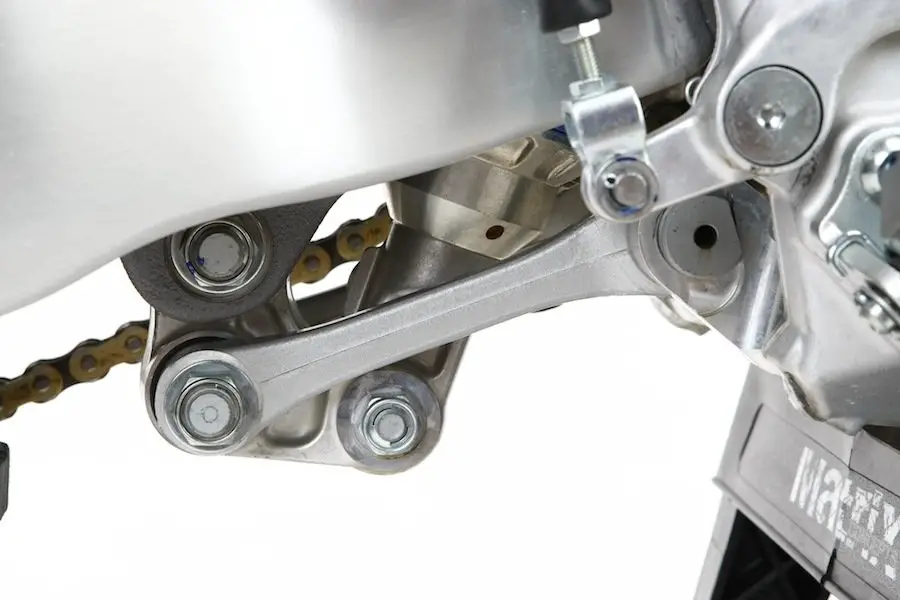
Q: FIRST, IS KAYABA’S SSS SUSPENSION STILL UP TO SNUFF IN AN AIR-FORK WORLD?
A: You bet. Compared to the forks on the Kawasaki, Honda, KTM, Suzuki and Husqvarna, the box-stock Kayaba SSS forks on the YZ450F are “works forks.” They are so much better than the new breed of air forks that it’s no contest.
Air forks have two major advantages over Kayaba SSS forks: (1) Air forks cost the manufacturers a lot less to purchase. Why are they cheaper? They don’t have expensive coil springs. They only have parts-intensive valving in one leg instead of two, and they are easier to assemble at the factory. Unfortunately, though they may be cheaper to produce and install at the factory, the consumer price does not reflect the cost savings. (2) Air forks are lighter than Kayaba SSS forks. How much lighter? Well over 2 pounds (based on the fact that there are no coil springs and one fork leg is effectively an empty tube filled with air).
How long can Yamaha’s R&D department ignore the weight and dollar savings just to spec the best forks on the track? We hope they turn a blind eye to air forks for a long time.
 Math equation: The real potential of Yamaha’s centralization of mass theories will not be fulfilled until the YZ450F loses some weight and bulk.
Math equation: The real potential of Yamaha’s centralization of mass theories will not be fulfilled until the YZ450F loses some weight and bulk.
Q: SECOND, HOW DO THE MAPPING CHANGES CONTRIBUTE TO THE YZ450F’S IMPROVEMENT?
A: Last year the MXA test riders only ran the stock mapping for one hour before breaking out the GYTR Power Tuner to pump up the fuel percentages and advance the ignition timing (to help burn the extra fuel). Our mapping eliminated the barky hit off the bottom, pumped up the middle and eliminated the lean stutter.
Thus, it is no surprise that the 2015 Yamaha YZ450F comes with a version of our 2014 map in stock trim. The big plus is that 2014 YZ450F owners can achieve the same powerband results by remapping their bikes.
The 2014 YZ450F’s barky and lean mid-to-top didn’t help the bike get smoothly through corners, because it had a powerband that lurched instead of flowed. The new map allows the front end to stay on the ground on exit instead of lifting off and ruining the turn.
Q: THIRD, IS ANYONE SENSITIVE ENOUGH TO FEEL THE DIFFERENCE BETWEEN A STEEL AND AN ALUMINUM MOTOR MOUNT?
A: You would be surprised how much difference changing the thickness, sizes, shapes and material for the motor mounts or head stays can make to a bike’s handling. Years ago, Yamaha’s head test engineer, Ed Scheidler, let the MXA wrecking crew test seven different head stays on a YZ250. The bike felt like a different machine with just a head-stay change. The new steel motor mounts will retrofit on last year’s YZ450F.
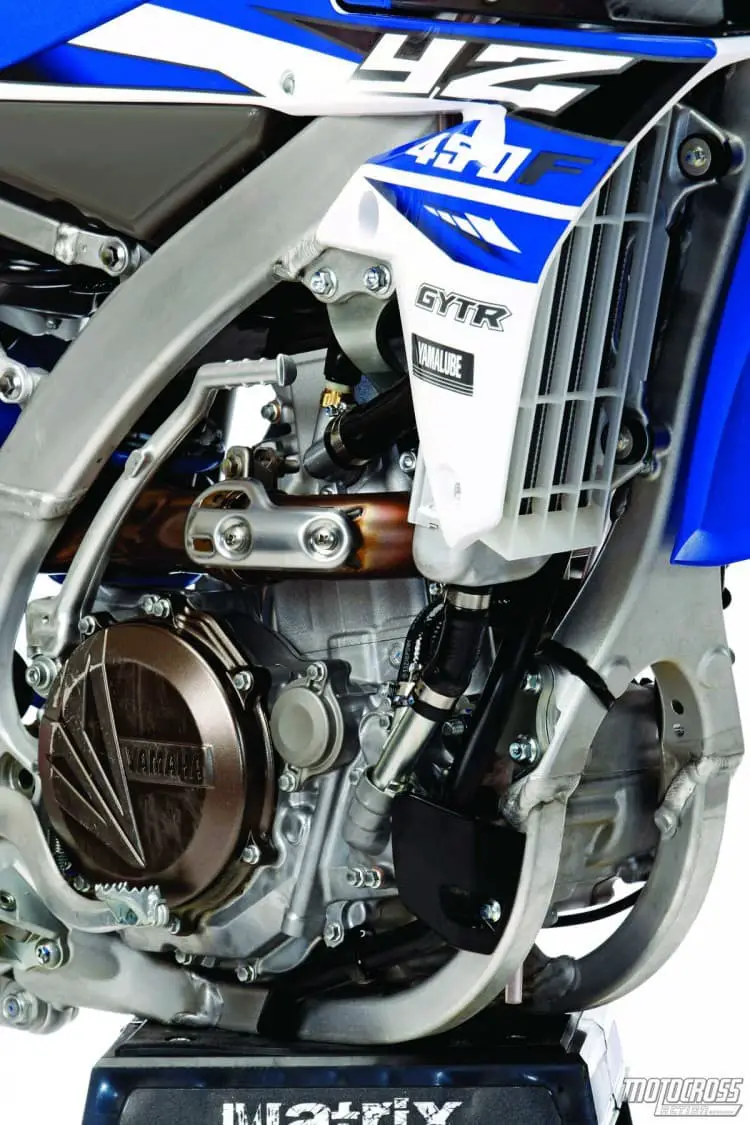 Thanks to the mapping changes, the YZ450F is smoother, more manageable and exhibits gentlemanly manners.
Thanks to the mapping changes, the YZ450F is smoother, more manageable and exhibits gentlemanly manners.
Q: FOURTH, WHY WOULD YAMAHA MAKE THE GEARING TALLER?
A: Yamaha is employing a trick that Honda used back in the old CR500 two-stroke days. When consumers complained that the CR500 was too powerful, Honda didn’t detune the engine; the engineers just added a smaller rear sprocket to mellow out the delivery. The CR500 power became more manageable because it had to pull a taller gear out of each corner, which translated into better throttle control, slower revs and the ability to stay in one gear longer.
Yamaha did the same thing with the 2015 Yamaha YZ450F by going from a 49-tooth rear sprocket to a 48-tooth sprocket. Yamaha is employing band-aid tactics, because in our opinion it made a major mistake with the 2014 gearbox, although Yamaha meant to do a good thing. In 2014, Yamaha decided to close up the big gap between second and third gear that racers had complained about for years. But, instead of raising second gear closer to third, the engineers lowered third gear. Unfortunately, they also changed the primary gear ratio to move all of the gears up. This was a bad move, because while they made the changes to close the gap between second and third gear, the result was a wider gap between third and fourth. To fix this flaw, Yamaha changed from its traditional 48-tooth rear sprocket to a lower 49-tooth sprocket (to allow the 2014 gearbox to mimic the 2013’s 48-tooth gearing).
To recap, in 2014 they moved the wrong gear down, then raised all the gears up, which created a big gap between the gear they moved down and the gear above it, forcing them to lower the gearing at the rear sprocket to get back to where they were in 2013. Now, they have raised the overall gearing by going to a taller 48-tooth sprocket in place of last year’s 49.
This comedy of gearbox errors resulted in a mellower power delivery for 2015, thanks to taller overall gearing. And, the mellower powerband helps the YZ450F’s turning prowess, especially from tip-in to center-out.
The MXA test riders weren’t sold on the gear ratios, but did like the effect on the chassis. Unfortunately, there is a loss of drive in the middle gears that can only be retrieved by serious hop-up dollars or a 49-tooth sprocket.
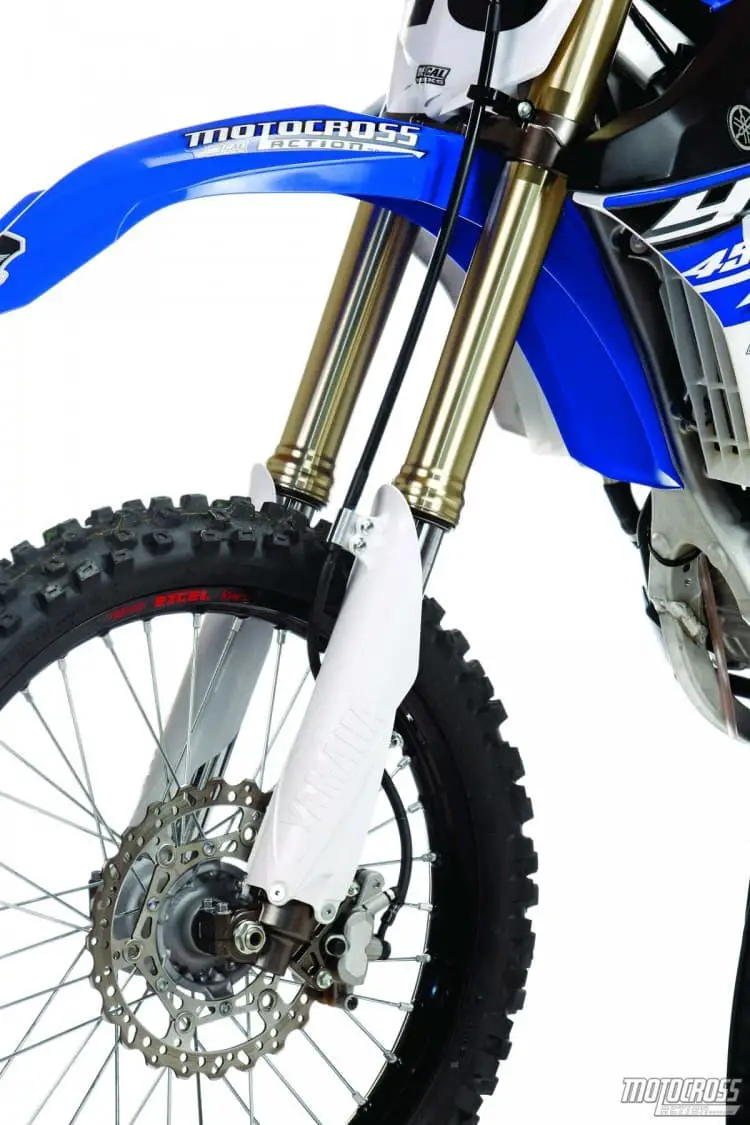 Because Yamaha got it right with its SSS suspension eight years ago, they don’t have to play fork roulette every year.
Because Yamaha got it right with its SSS suspension eight years ago, they don’t have to play fork roulette every year.
Q: IS THE 2015 YZ450F FASTER THAN THE 2014 YZ450F?
A: No, but it is smoother than the 2014 YZ450F, and that makes it easier to go fast on. From gear to gear, the 2014 had more thrust, largely due to the lower gearing and more aggressive mapping, but don’t shed a tear for the YZ450F’s powerband. No need. The YZ450F is the most powerful 450 on the track. It pumps out close to 59 horsepower in stock trim, and an aftermarket pipe will easily push it over 60 horses.
This usable power from bottom to top is made all the more usable by the map and gearing changes. And, of course, it can be made faster with a different map and gearing changes.
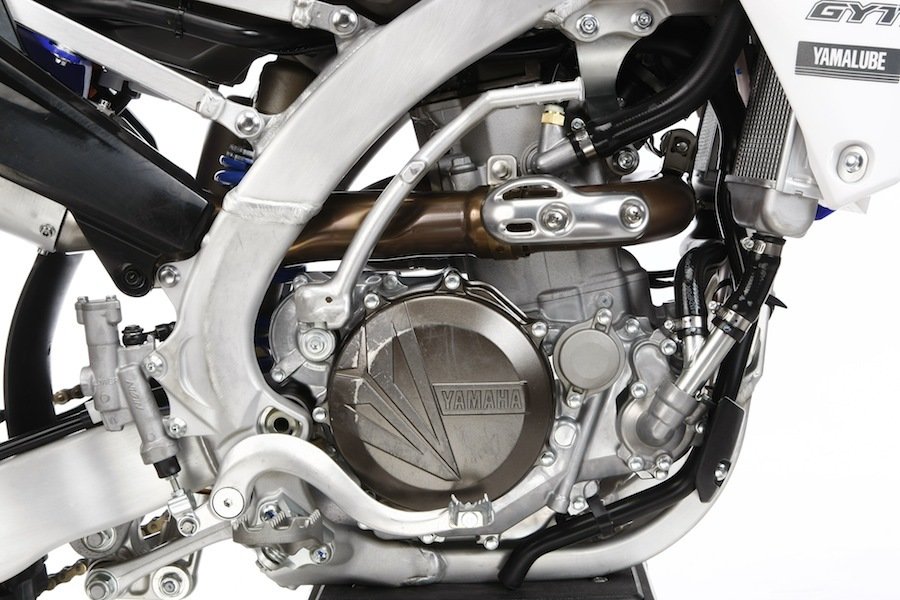
Q: WHAT ABOUT THE SLANT-BACK ENGINE DESIGN?
A: We love the creativity of both Yamaha’s and Husaberg’s backwards engines. They work by harnessing the rotating mass and gyroscopic forces of the engine’s moving parts to make the bike feel lighter in roll, pitch and yaw. However, the real benefits of the slant-back design are muted by the fact that neither the YZ450F nor the now-departed Husaberg FE450 were light enough to take full advantage of the physics involved. Thus, you have a Yamaha engine department trying to make the bike feel smaller and lighter, while the chassis department builds a bull moose of a bike that all but nullifies the high-falutin science.
Q: HOW DOES THE 2015 YZ450F HANDLE?
A: The handling is better in 2015 than it was in 2014, which was better than in 2013. And even though the MXA wrecking crew has been critical of the front-end response of the YZ450F since 2007, we are beginning to warm to the YZ450F’s geometry.
By no stretch is it the best handling bike on the track, but Yamaha’s engineers, especially in the engine division, are nibbling away at the loose feel at turn-in. Still, changes to the powerband, gearing and motor mounts aren’t enough. It is obvious that the chassis department should contribute more to the solution, since the chassis is obviously the problem. The YZ450F is too tall in the rear. Conversely, it feels too wide at the radiators and too heavy everywhere. Yet, on the scale and on the tape measure, the YZ450F isn’t overly wide or overly heavy. It just feels like it is.
Luckily for the YZ450F racer, the new powerband and awesome suspension can mask the most glaring flaws in the design. We opted to run 105mm of sag to bring the rear of the chassis down, aided by a longer Pro Circuit linkage, while moving the forks up and down in the clamps to find the balance we wanted. Equally important to the YZ450F is the choice of front tires. Although the stock Dunlop MX52 is okay, we would choose terrain-specific rubber, like the MX32, Bridgestone MX30 or X40 for our SoCal tracks. A good front tire civilizes the YZ450F at tip-in.
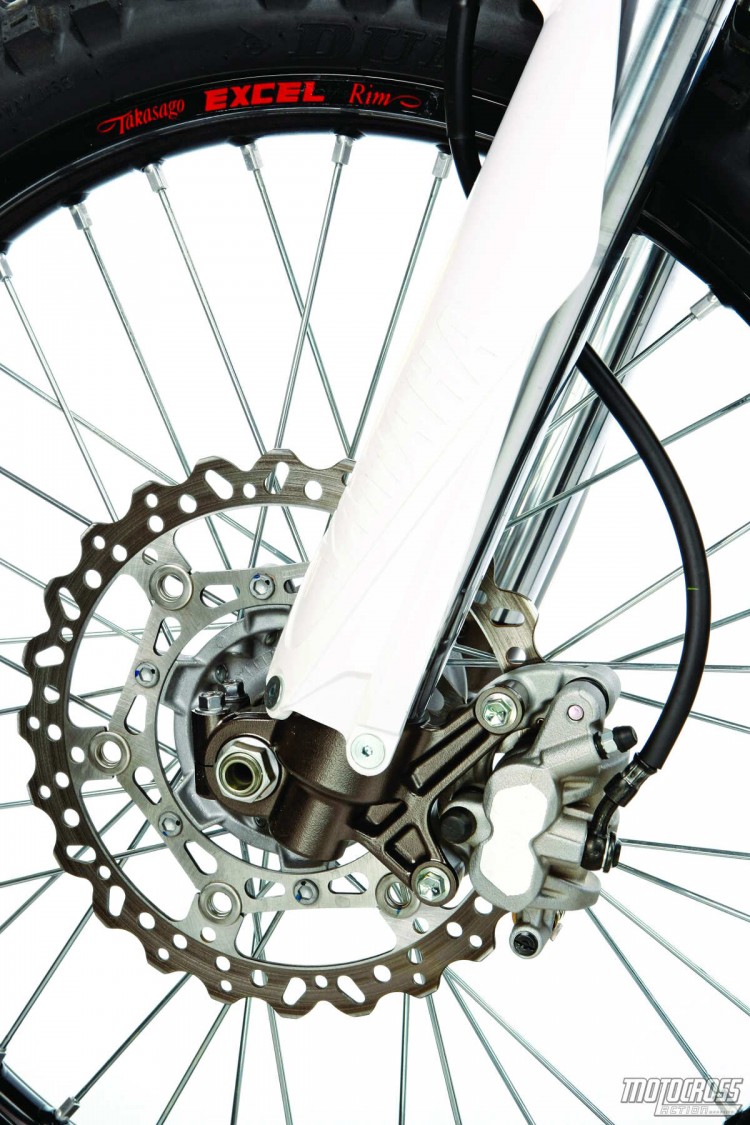 The Yamaha YZ450F’s old-school front brake isn’t even a contender in the pucker-power derby.
The Yamaha YZ450F’s old-school front brake isn’t even a contender in the pucker-power derby.
Q: WHAT DID WE HATE?
A: The hate list:
(1) Brakes. What brakes? Kawasaki and Honda have responded to KTM’s superiority with oversize rotors for 2015. Yamaha and Suzuki have not. We’d rate the YZ brakes second to last and the RM-Z brakes dead last.
(2) Yamaha-thumb. Blood in the glove is never a nice thing. A grip donut can stop the bleeding.
(3) Dzus fasteners. Love the idea, but the two fasteners on the side of the radiator wings took flight. Why? Because when your knees hit the shrouds and the plastic flexes, it unlocks the quarter-turn fasteners and they fall out. Plus, your leathers can catch on the D-rings and flip them open. Put tape over them, remove the D-rings (and use a screwdriver) or switch back to bolts.
(4) Gearing. Experiment with a 49 or a 50 for your local track.
(5) Radiator wings. You can’t do much about how wide the YZ450F feels at the radiators, but Cycra shrouds, designed with the help of the JGR team, not only make the bike narrower at the gas tank but make it breathe better and weigh a lot less.
(6) Gas-cap vent hose. We drill a hole in the front of the airbox cover and route the vent hose under the cover for a cleaner look.
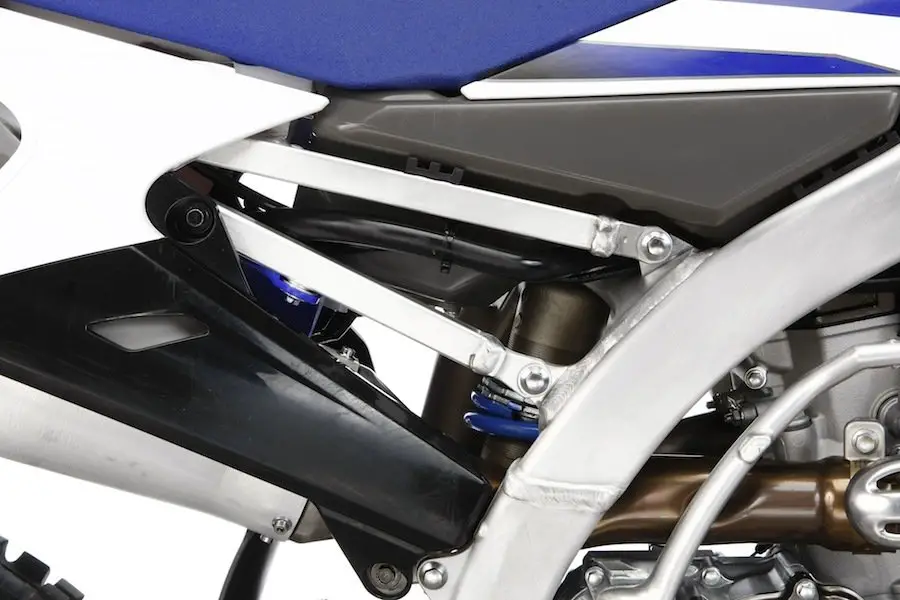 The muffler is actually a structural part of the left subframe.
The muffler is actually a structural part of the left subframe.
Q: WHAT DID WE LIKE?
A: The like list:
(1) GYTR Power Tuner. The GYTR Power Tuner ($279.95) is the easiest-to-use programming tool in the sport. It’s like a Playstation for your fuel injection. The other brands’ mapping systems are modern Manhattan Projects.
(2) Suspension. Kayaba’s old-school forks put all the fancy air forks to shame. The buzz of air forks will have a hard time beating the performance of Yamaha’s SSS units.
(3) Reliability. Nothing is as reliable as a Yamaha YZ450F.
(4) Clutch. We confess to adding stiffer clutch springs, but after Husky’s and KTM’s hydraulic clutches, the YZ450F is third best.
(5) Power. One of the hidden benefits of making the most horsepower is that you can give and take to make it more effective—without making the bike slower. The YZ450F is the most powerful 450 on the showroom floor in 2015.
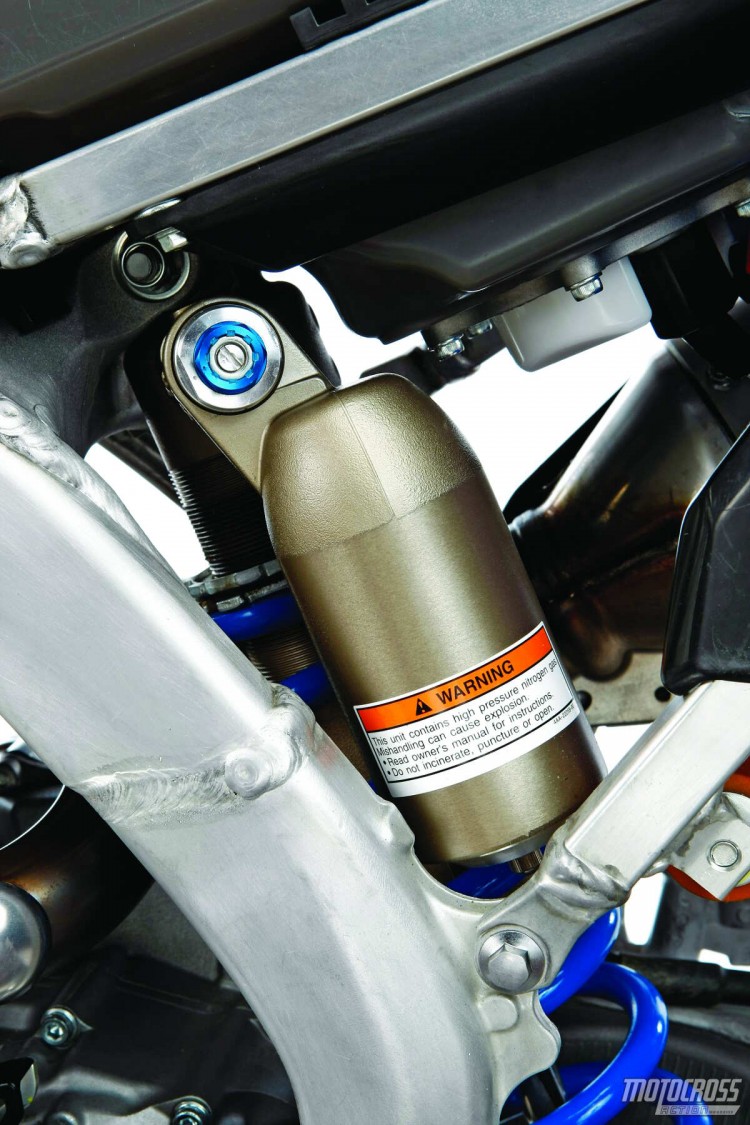 The Kayaba shock is easily accessible on the left side of the bike for preload or clicker adjustments.
The Kayaba shock is easily accessible on the left side of the bike for preload or clicker adjustments.
Q: WHAT DO WE REALLY THINK?
A: There is a paradox at work here. Yamaha paired its new-wave engine design with old-school forks to produce a bike that offers very impressive performance. The engineers have even ironed out the wrinkle at turn-in. Good stuff—very good indeed.
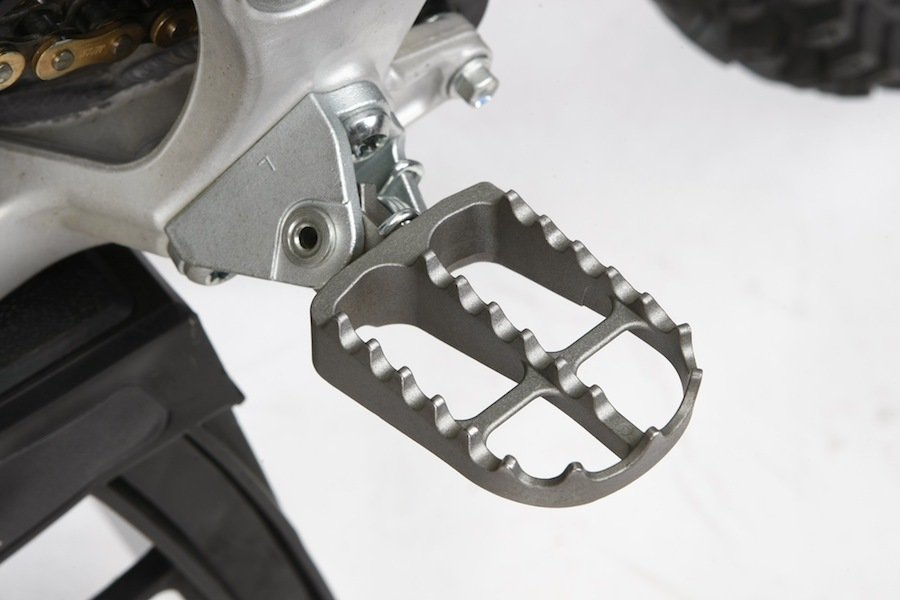
MXA YAMAHA YZ450F SETUP SPECS
This is how we set up our 2015 Yamaha YZ450F for racing. We offer it as a guide to help you find your own sweet spot.
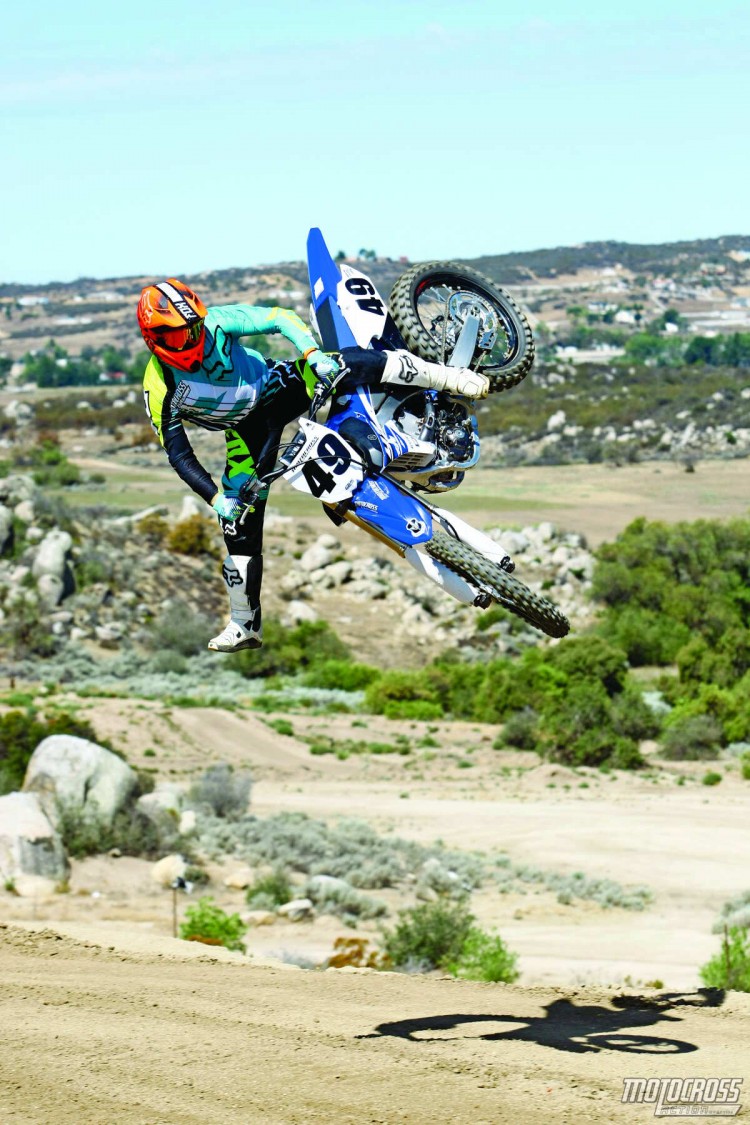 Too hip: Beaucoup power and great suspension add up to instant bravery.
Too hip: Beaucoup power and great suspension add up to instant bravery.
KAYABA SSS FORK SPECS
While Honda, Suzuki and Kawasaki are scrambling to get their air forks to work—and gambling on them with your money—Yamaha has been sitting on the suspension sweet spot for 8 years. Last year, Yamaha’s engineers went a little too Pro-level on their suspension settings, but this year they backed off on the stiffness to produce the plushest stuff around. For hardcore racing, these are MXA’s recommended 2015 Yamaha YZ450F fork settings (stock settings are in parentheses).
Spring rate: 0.50 Nm
Oil quantity: 315cc
Compression: 10 clicks out (8 clicks out)
Rebound: 8 clicks out (10 clicks out)
Fork-leg height: 4mm up
Notes: Seeing the error in its ways after 2014, Yamaha lowered the oil height by 10cc, added slightly stiffer 0.50 Nm springs and revised the valving for a plusher feel. The oil height is 10cc lower in 2015, but this is just to compensate for the stiffer fork springs. Even with the stiffer fork springs, the forks are softer.
KAYABA SHOCK SETTINGS
One of the nicest things about the YZ450F’s shock is how easy it is to access. With some bikes, adjusting the preload is tougher than taking the LSATs. Not so with the Yamaha. The clickers and spring preload are exposed to the light of day, thanks to the wraparound exhaust system. For hardcore racing, these are MXA’s recommended 2015 YZ450F shock settings (stock settings are in parentheses).
Spring rate: 5.8 Nm
Race sag: 105mm (100mm)
Hi-compression: 2 turns out (1-1/2 turns out)
Lo-compression: 12 clicks out
Rebound: 9 clicks out (14 clicks out)
Notes: We ran a longer 143.5mm Pro Circuit shock linkage (not solely for suspension purposes, but also to give us more adjustment room with the head angle and frame geometry). The longer link drops the rear of the bike almost 8mm and stiffens the initial part of the stroke. We compensate for this move by turning the high-speed compression out a half-turn and the rebound in five clicks.

Click here to subscribe to MXA: https://hi-torque.com/motocrossaction






Comments are closed.